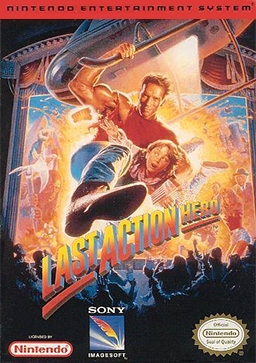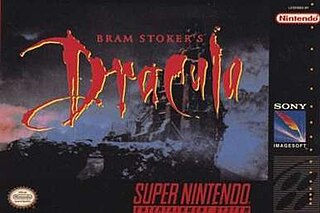
Zool: Ninja of the Nth Dimension is a platform game written for the Amiga by Gremlin Graphics and published in 1992. It was marketed as a rival to Sega's Sonic the Hedgehog. Zool was ported to other platforms and followed by Zool 2 in 1993.

Earthworm Jim is a 1994 run and gun platform game developed by Shiny Entertainment, featuring an earthworm named Jim, who wears a robotic suit and battles the forces of evil. The game was released for the Sega Genesis and Super Nintendo Entertainment System, before being subsequently ported to a number of other video game consoles.

Mortal Kombat II is a fighting game originally produced by Midway for the arcades in 1993. It was ported to multiple home systems, including MS-DOS, Amiga, Game Boy, Game Gear, Sega Genesis, 32X, Sega Saturn, Super Nintendo Entertainment System, and PlayStation only in Japan, mostly in licensed versions developed by Probe Software and Sculptured Software and published by Acclaim Entertainment.

Last Action Hero is a series of action video games based on the 1993 film of the same name. Versions were released for the NES, Super NES, Sega Genesis, Game Boy, Game Gear, and MS-DOS. Versions were also planned for the Sega CD and Master System, but ultimately were not released.

Ultimate Mortal Kombat 3 is a fighting game in the Mortal Kombat series, developed and released by Midway to arcades in 1995. It is a standalone update of 1995's earlier Mortal Kombat 3 with an altered gameplay system, additional characters like the returning favorites Reptile, Kitana and Scorpion who were missing from Mortal Kombat 3, and some new features.

Fatal Fury 2, known as Garō Densetsu 2: Aratanaru Tatakai in Japan, is a 1992 fighting video game released by SNK for the Neo Geo arcade and home platforms, and later ported to several other home systems. It is the sequel to Fatal Fury: King of Fighters (1991) and the second game in the Fatal Fury franchise. Its updated version, Fatal Fury Special, was released in 1993.

Bram Stoker's Dracula is a 1993 video game released for the Mega Drive/Genesis, Nintendo Entertainment System, Super NES, Game Boy, Master System, Sega CD, Game Gear, MS-DOS, and Amiga. It is based on the 1992 film Bram Stoker's Dracula which in turn is based on the 1897 novel Dracula by Bram Stoker. Most versions are platform games. The Sega CD and Amiga releases are beat 'em ups, and the MS-DOS version is a first-person shooter. The Amiga version was released in 1994 for North America and Europe. A CD-ROM version for MS-DOS compatible operating systems was released in 1995.

Wolfchild is a platform game originally released for the Amiga and the Atari ST by Core Design in 1992. It was later released for the SNES, Mega Drive/Genesis, Sega CD, Master System, and Game Gear.

The Genesis, also known as the Mega Drive outside North America, is a 16-bit fourth generation home video game console developed and sold by Sega. It was Sega's third console and the successor to the Master System. Sega released it in 1988 in Japan as the Mega Drive, and in 1989 in North America as the Genesis. In 1990, it was distributed as the Mega Drive by Virgin Mastertronic in Europe, Ozisoft in Australasia, and Tectoy in Brazil. In South Korea, it was distributed by Samsung Electronics as the Super Gam*Boy and later the Super Aladdin Boy.

There have been several video games based on the 1991 film Hook. A side-scrolling platform game for the Nintendo Entertainment System (NES) and Game Boy was released in the United States in February 1992. Subsequent side-scrolling platform games were released for the Commodore 64 and the Super Nintendo Entertainment System (SNES), and an arcade beat ‘em up by Irem later in 1992, followed by versions for the Sega CD, Sega Genesis, and Sega's handheld Game Gear console in 1993.

Teenage Mutant Ninja Turtles: Tournament Fighters, or Teenage Mutant Hero Turtles: Tournament Fighters in Europe, is the title of three different fighting games based on the Teenage Mutant Ninja Turtles, produced by Konami for the Nintendo Entertainment System, Sega Genesis, and Super NES and released during a period between 1993 and 1994. Konami produced a different fighting game based on the franchise each featuring a differing cast of characters for the platforms. All three versions of the game were re-released as part of Teenage Mutant Ninja Turtles: The Cowabunga Collection in 2022. with online play using rollback netcode for the SNES version of the game.

Maui Mallard in Cold Shadow – originally released as Donald in Maui Mallard – is a platforming video game developed and published by Disney Interactive Studios. The game was released in Europe on December 8, 1995, and in Brazil in spring 1997 for the Sega Mega Drive. It was also ported by Eurocom Entertainment Software to the SNES and released in North America in January 1997, in Europe mostly in autumn 1996, and in Japan on December 20, 1996. A Microsoft Windows port was released in North America in November 1996. It was ported one last time to the Game Boy by Bonsai Entertainment Corp., released in North America in August 1998.

3 Ninjas Kick Back is a 1994 American martial arts film directed by Charles T. Kanganis. It is a sequel to the film 3 Ninjas. Despite being released as the second installment of the franchise, Kick Back is chronologically the third installment of the 3 Ninjas series. Originally the other sequel 3 Ninjas Knuckle Up was shot back-to-back with the first film and with the original cast, but due to distribution issues it was released in 1995. Max Elliott Slade is the only actor to reprise his role from the previous films as Jeffrey "Colt" Douglas, one of the three main characters. The film has a continuity error in which Mori's last name changes from Tanaka to Shintaro for no apparent reason.

The Adventures of Batman & Robin is a series of video game adaptations released between 1994 and 1995 featuring the DC Comics characters Batman and Robin based on Batman: The Animated Series. The games were released for numerous platforms, with the Genesis, Game Gear, and Sega CD versions published by Sega while the Super NES version was published by Konami.

Mighty Morphin Power Rangers is the title of five different video games based on the first season of the television series of the same name, one for each of the following game platforms: Sega Genesis/Mega Drive, Super Nintendo Entertainment System, Game Boy, Game Gear, and Sega CD. The Nintendo versions of the game were released by Bandai, while the Sega versions were published by Banpresto, a pseudonym of Bandai. The Green Ranger is only playable on the Genesis and Game Gear versions of the game.

Dragon: The Bruce Lee Story is a fighting video game developed and originally published by Virgin Interactive Entertainment in Europe for the Sega Genesis in June 1994. It is based on the 1993 film of the same name, which is a semi-fictionalized account of the life of Hong Kong-American actor and martial artist Bruce Lee. Following the events of the movie, players take control of Bruce Lee across several stages that takes places in different time periods of his life and fight against some of his adversaries.

Mighty Morphin Power Rangers: The Movie is the title of four different video game adaptations of the film of the same name which were released for the Super NES, Genesis, Game Boy and Game Gear. While the games were ostensibly based on the film, they also featured characters and plot elements from the second season of the original TV series. Like the previous game versions of the original Mighty Morphin Power Rangers, none of the four versions of the movie game were ports of each other.

Samurai Shodown, known in Japan as Samurai Spirits, is a fighting game developed and published by SNK for the Neo Geo arcade and home platform. Released in 1993, it is the first installment in the Samurai Shodown series. In contrast to other fighting games at the time, which were set in modern times and focused primarily on hand-to-hand combat, Samurai Shodown is set in feudal-era Japan and was SNK's first arcade fighting game to focus primarily on weapon-based combat.

Mortal Kombat is a 1992 fighting game developed and published by Midway. It is the first entry in the Mortal Kombat series and was subsequently released by Acclaim Entertainment for nearly every home platform at that time. The game focuses on several characters of various intentions who enter a martial arts tournament with worldly consequences. It introduced many key aspects of the Mortal Kombat series, including the unique five-button control scheme and gory finishing moves called Fatalities.
3 Ninjas is a series of action comedy family films about the adventures of three young brothers who are trained by their Japanese grandfather in the art of Ninjutsu. Victor Wong is the only cast member to appear in all four films.


















